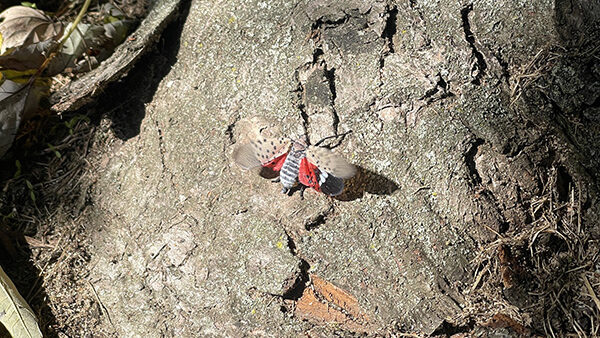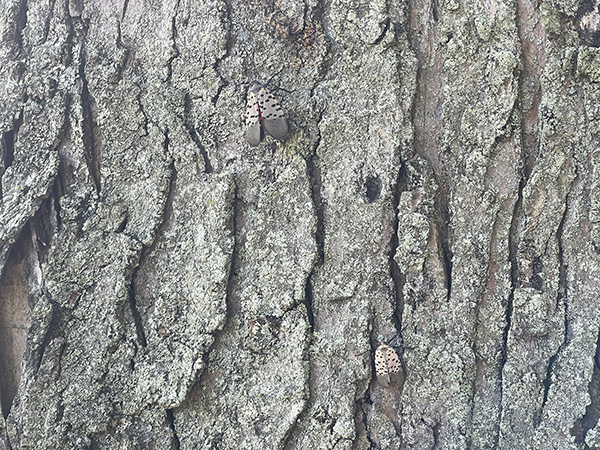
By Jody Sackett, Rumson Environmental Commission
To squish or not to squish? For the squeamish, it’s not even a question. But for the rest of us, we wonder.
For those not familiar with the insect causing everyone to stomp around this fall, the Spotted Lanternfly (Lycorma delicatula) is a planthopper native to China and was first detected in North America in Pennsylvania in September 2014. It’s a pretty bug with polka dots on its gray-brown wings and bright red underwings, looking like a moth dressed up for a party.
So why is the spotted lanternfly (SLF) the invasive star of the year? It doesn’t bite or sting, doesn’t carry disease, and doesn’t eat our food, wooden homes or wool clothes.
That’s the good news.
The bad news is the SLF is a voracious feeder and its favorite target is Tree of Heaven, a common invasive tree that grows pretty much everywhere in New Jersey. With such a ubiquitous target, you’d think the SLF wouldn’t need to look elsewhere for food, but unfortunately it does, feeding on a variety of plants.
Considered a nuisance pest, SLF may not kill the plants it eats, but the feeding causes stress that weakens them. SLF can destroy crops like grapevines and hops, even maple and black walnut trees. Damage from the spotted lanternfly includes oozing sap, leaf curling, wilting and dieback. Additionally, as the insects feed, they excrete honeydew, a sugary substance that attracts insects such as bees and wasps, and promotes sooty mold growth on the feeding surfaces.
This potential for serious damage is why the New Jersey Department of Agriculture has proposed regulations to expand the state’s SLF quarantine areas to every county in the state. Spotted lanternflies spread as hitchhikers, hiding in a variety of places like building materials, boats and trailers, and cars. When these items are moved to a new location, their secret passengers go, too, spreading the range of SLF. That’s why it’s important to check they aren’t accidentally being transported.
So how does one do that?
Spotted lanternfly adults and their young, known as nymphs, often gather in large numbers on host plants, and at twilight can be easily found migrating up and down the trunk of the tree or plant. The nymphs look like black beetles with white spots on their back when they are young, but as they mature, they change colors to red and black backs with white spots. Nymphs often feed in tree canopies, but when they are blown or knocked out, they fall to the ground, walk to the trunk of trees and climb back up to start feeding again. They are clever concealers, and will also hide in motorcycles, backpacks, backyard benches, firewood, bicycles, garden tools and a host of other common places. Look for the distinctive red shell coloring in the older nymphs and on the adult wings.

Eggs are another way the spotted lanternfly spreads. In late summer, especially October, adults will lay brownish-gray eggs masses about 1.5 inches long – each containing 30-50 eggs – on hard surfaces such a tree bark, stones, even patio walls and furntire. The egg masses contain rows of tiny eggs, which the female has covered with a brownish substance to protect them. These egg masses will survive the winter and hatch into nymphs in the spring. Older egg masses up to two years old can still be found on trees and other hard surfaces, but the eggs aren’t viable anymore if the top brownish substance isn’t there; tiny emergence egg holes by which the nymph has exited the egg can be seen on these leftover masses.
To help control the spread, get rid of the egg masses. Scrape them off the tree or hard surface using a plastic card or knife. Since egg masses scraped to the ground can still hatch, be sure to scrape the eggs into a bag or container filled with rubbing alcohol or hand sanitizer to kill them. You can also smash the egg masses, but make sure you don’t just knock them to the ground; a properly crushed egg mass bursts open.
Adults cannot survive the winter, but there are controlling measures to take now that don’t involve pesticides. Definitely squish them when you see them on the ground, on plants, or on patio furniture. Spray them with white vinegar, neem oil (an organic biopesticide and natural fungicide), or a mixture of soapy water with a bit of oil, which kills them nearly instantly.
Egg masses are not viable until laid by the female, so if killing an adult female still full of eggs is hitting the jackpot.
Spotted lanternflies have few natural predators, but praying mantises, insects, spiders and frogs may eat them, although they are not significant controllers. Most birds won’t eat them. A proactive step can also involve setting traps to capture the adults and nymphs as they crawl up the trees. But don’t use sticky bands around tree trunks for this: The tape will also capture other nontargeted critters like birds, beneficial insects and small mammals. Instead, use a trap that was originally designed to control pecan weevils, called a Circle Weevil trap, comprised of netting that is wrapped around and stapled to a tree. The netting forces climbing spotted lanternflies (adults and nymphs) upward into a plastic collection funnel where they are trapped and eliminated. These traps can easily be homemade as well as purchased.
So next time you see a “dressed-up” spotted lanternfly, be sure to let them know the party’s over.
The article originally appeared in the October 20 – 26, 2022 print edition of The Two River Times.














